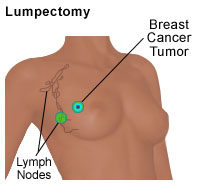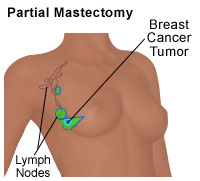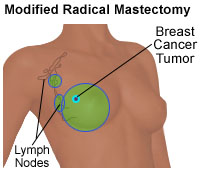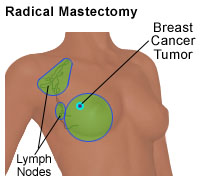Surgery for Breast Cancer Treatment
How is surgery used in breast cancer treatment?
Surgery to remove as much of the cancer as possible is the primary treatment for breast cancer. Today, women have many surgical options. The type of surgery done depends on:
-
The size and location of the breast lump or tumor
-
The type and stage of the breast cancer (if the cancer has spread within the breast or has spread outside of the breast to the lymph nodes, or to other parts of the body.)
-
The size of the breast
-
The woman's preference
There are several types of breast surgery. Your doctor can explain the benefits and risks of each type, and answer any questions or concerns you may have prior to surgery.
Questions to ask your doctor before surgery
Here are suggestions of what to ask your doctor:
-
Which type of surgery do you recommend for me? Why?
-
Where will the incision (cut) be and how much breast tissue will be removed?
-
Will any lymph nodes be removed?
-
Will I be able to have breast reconstruction if I have a mastectomy?
-
Do you recommend breast reconstruction at the same time of the mastectomy surgery or at a later date?
-
Will I need more treatment, such as radiation or chemotherapy, after surgery?
-
What type of follow-up care is needed?
-
How long will it be before I can go back to my normal activities?
What are some of the different types of breast cancer surgery?
There are 2 types of breast conservation (tissue-sparing) surgery. These include a lumpectomy and a partial (segmental) mastectomy.
|

|
A lumpectomy is the removal of the breast cancer and a portion of normal tissue around the breast cancer lump (the areas removed during the surgery are shaded in green). The surgeon may also remove some of the lymph nodes under the arm to determine if the cancer has spread. The bean-shaped lymph nodes under the arm (also called the axillary lymph nodes) drain the lymphatic vessels from the upper arms, the majority of the breast, the neck, and the underarm regions. Often, breast cancer spreads to these lymph nodes, enters the lymphatic system, and spreads to other parts of the body. Radiation therapy is often given after a lumpectomy to destroy cancer cells that may not have been removed during the lumpectomy procedure.
|
|

|
A partial (segmental) mastectomy involves the removal of the breast cancer and a larger portion of the normal breast tissue around the breast cancer (the areas removed during the surgery are shaded in green). The surgeon may also remove the lining over the chest muscles below the tumor and some of the lymph nodes under the arm. The bean-shaped lymph nodes under the arm (also called the axillary lymph nodes) drain the lymphatic vessels from the upper arms, the majority of the breast, the neck, and the underarm regions. Often, breast cancer spreads to these lymph nodes, enters the lymphatic system, and spreads to other parts of the body. Radiation therapy may also be given after a partial mastectomy to destroy cancer cells that may not have been removed during the partial mastectomy procedure.
|
Mastectomy, a non-breast-conserving procedure
If a woman does not choose a breast-conserving surgery, she may choose a mastectomy (removal of the breast). The doctor may recommend a mastectomy as the best surgical option under the following circumstances (among others):
-
If the cancer has spread to other parts of the breast tissue or has spread to the lymph nodes under the arm
-
If the woman has already had radiation therapy to the affected breast
-
If there are 2 or more areas of cancer in the same breast that are too far apart to be removed through one surgical incision and allow a satisfactory appearance
-
If the breast is very small and a lumpectomy would require removing additional breast tissue, resulting in a very deformed breast
There are 3 types of mastectomy. Your doctor can explain the benefits and risks of each type:
|

|
During a total (or simple) mastectomy, the surgeon removes the entire breast (including the nipple, the areola, and most of the overlying skin) and may also remove some of the lymph nodes under the arm, also called the axillary lymph nodes (the areas removed during the surgery are shaded in green). The bean-shaped lymph nodes under the arm drain the lymphatic vessels from the upper arms, the majority of the breast, the neck, and the underarm regions. Often, breast cancer spreads to these lymph nodes, enters the lymphatic system, and spreads to other parts of the body.
A skin-sparing mastectomy removes the same amount of breast tissue but leaves most of the skin, except for the nipple and areola. This may be an option if immediate breast reconstruction will be done.
|
|

|
During a modified radical mastectomy, the surgeon removes the entire breast (including the nipple, the areola, and the overlying skin), some of the lymph nodes under the arm (also called the axillary lymph nodes), and the lining over the chest muscles. In some cases, part of the chest wall muscles is also removed (the areas removed during the surgery are shaded in green).
|
|

|
During a radical mastectomy, the surgeon removes the entire breast (including the nipple, the areola, and the overlying skin), the lymph nodes under the arm, also called the axillary lymph nodes, and the chest muscles (the areas removed during the surgery are shaded in green). For many years, this was the standard operation. However, today, a radical mastectomy is rarely performed and is generally only recommended when the breast cancer has spread to the chest muscles.
|
Schedule a Mammogram at Richmond University Medical Center
Early detection and treatment is the best strategy for a better cancer outcome. Schedule your mammogram at RUMC: Call 718-818-3280.
Kathy Giovinazzo is Director of Radiology at Richmond University Medical Center.
For More Information
For more information or to schedule an appointment, contact Dr. Thomas Forlenza at 718-816-4949. His office is located at 1366 Victory Blvd on Staten Island.
Dr. Forlenza is the Director of Oncology at Richmond University Medical Center.
© 2000-2025 The StayWell Company, LLC. All rights reserved. This information is not intended as a substitute for professional medical care. Always follow your healthcare professional's instructions.